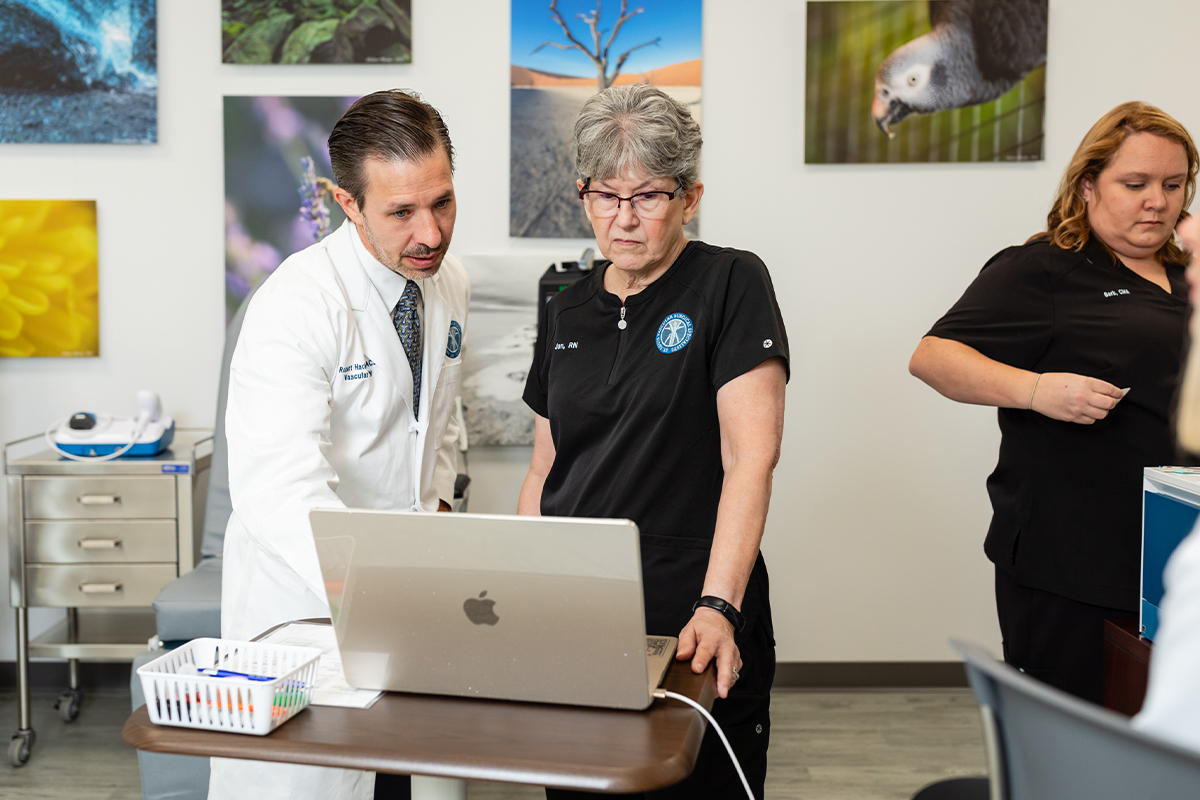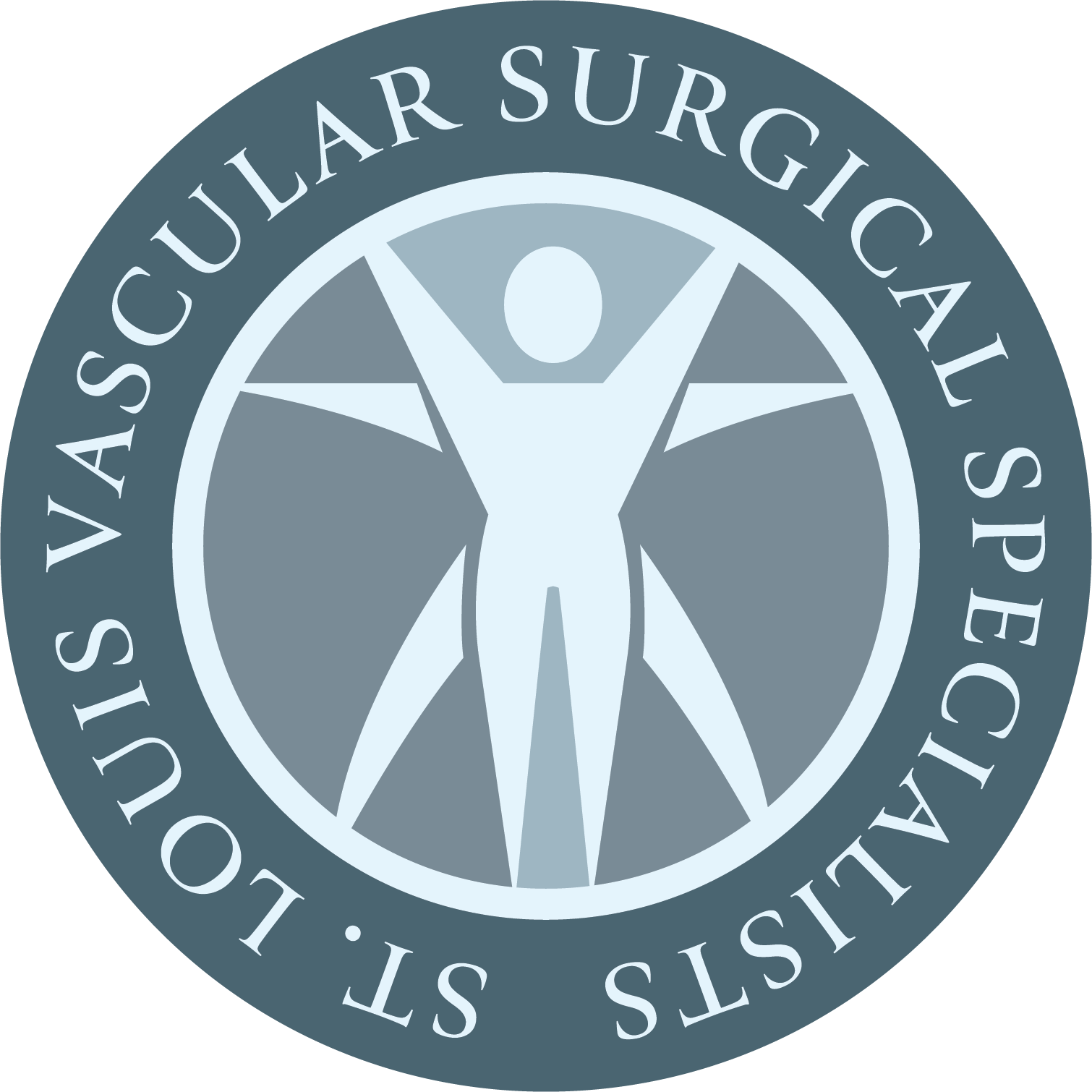Vascular conditions encompass a range of disorders that affect the blood vessels, including the arteries, veins, and capillaries. At St. Louis Vascular Surgical Specialists, we are dedicated to addressing these conditions, from atherosclerosis to varicose veins and beyond, with advanced treatments and compassionate care tailored to each patient’s unique needs.
Potential symptoms of vascular conditions:
- Pain or cramping in the legs, especially during activity (claudication)
- Swelling or heaviness in the legs or ankles
- Persistent high blood pressure
- Difficulty speaking or understanding speech (aphasia)
- Skin changes, such as ulcers or discoloration, particularly in the lower extremities
- Numbness or weakness in the limbs
- Difficulty with wound healing
- Coldness or changes in skin temperature in affected areas
- Difficulty breathing or chest pain (in cases of cardiovascular vascular conditions)
- Headaches or vision changes (in cases of cerebrovascular conditions)
- Erectile dysfunction (in cases of vascular conditions affecting pelvic arteries)
Personalized vascular treatments at SVSS
At St. Louis Vascular Surgical Specialists (SVSS), we offer personalized care to address your unique vascular condition. Led by double-board-certified vascular surgeon Dr. Robert Hacker, our team offers a comprehensive array of treatments tailored to your specific needs. When you come to SVSS, Dr. Hacker will meet with you personally, conduct thorough vascular imaging tests, and discuss your symptoms and medical history in detail. Following this comprehensive evaluation, Dr. Hacker will utilize state-of-the-art diagnostic tools to pinpoint the exact nature and severity of your vascular condition. With this information, he will work closely with you to develop a customized treatment plan that aligns with your goals. Whether you require minimally invasive procedures, medication management, lifestyle modifications, or surgical intervention, Dr. Hacker and the SVSS team are dedicated to supporting you and helping you achieve optimal vascular health.

Some of the most common vascular conditions
Atherosclerosis
Atherosclerosis is a prevalent vascular condition characterized by the buildup of plaque in the arteries. This plaque consists of fatty deposits, cholesterol, cellular waste, calcium, and other substances. Over time, these deposits can harden and narrow the arteries, reducing blood flow to vital organs and tissues. Atherosclerosis is often asymptomatic until it progresses significantly, leading to symptoms such as chest pain (angina), leg pain while walking (claudication), or even serious complications like heart attack or stroke.
Peripheral Artery Disease (PAD)
Peripheral artery disease (PAD) is a type of atherosclerosis that specifically affects the arteries outside the heart and brain, most commonly those supplying the legs. In PAD, the narrowing of these arteries reduces blood flow to the limbs, leading to symptoms such as leg pain, cramping, weakness, or numbness, especially during physical activity. PAD is often underdiagnosed but is a significant risk factor for cardiovascular events like heart attack and stroke.
Deep Vein Thrombosis (DVT)
Deep vein thrombosis (DVT) is characterized by the formation of blood clots within deep veins, typically in the legs. These clots can partially or completely block blood flow, leading to symptoms like swelling, pain, warmth, and redness in the affected limb. DVT can arise from various factors, including prolonged immobility, surgery, or genetics. If a clot dislodges and travels to the lungs, it can cause a life-threatening condition known as pulmonary embolism.
Chronic Venous Insufficiency (CVI)
Chronic venous insufficiency (CVI) is a condition in which the veins in the legs fail to efficiently return blood to the heart, leading to blood pooling in the lower extremities. This can occur due to damaged vein valves that fail to effectively pump blood toward the heart. Symptoms of CVI include leg swelling, pain or aching, skin discoloration or ulcers, and varicose veins. Left untreated, CVI can progress to complications like venous ulcers or deep vein thrombosis.
Varicose Vein
Varicose veins are enlarged, twisted veins that often appear blue or purple and may bulge out from the skin’s surface, most commonly in the legs. This condition occurs when the valves within the veins weaken or become damaged, causing blood to pool and veins to stretch. Varicose veins are primarily a cosmetic concern but can also lead to symptoms such as aching, throbbing, or heaviness in the legs, especially after prolonged standing or sitting.

Aortic Aneurysm
An aortic aneurysm is a bulge or ballooning in the aorta, the body’s largest artery that carries oxygen-rich blood from the heart to the rest of the body. Aneurysms can develop anywhere along the aorta but are most common in the abdominal or thoracic regions. They often go unnoticed until they rupture, which can lead to life-threatening internal bleeding. Aortic aneurysms may be caused by atherosclerosis, genetic factors, trauma, or infection.
Cerebrovascular Disease
Cerebrovascular disease encompasses a range of conditions that affect the blood vessels supplying the brain. These conditions include ischemic stroke, caused by a blockage or clot in a cerebral artery, and hemorrhagic stroke, caused by a rupture in a blood vessel within the brain. Symptoms of cerebrovascular disease can vary widely but may include sudden weakness or paralysis on one side of the body, slurred speech, vision changes, or severe headaches.
Deep Vein Thrombosis (DVT)
Deep vein thrombosis (DVT) is characterized by the formation of blood clots within deep veins, typically in the legs. These clots can partially or completely block blood flow, leading to symptoms like swelling, pain, warmth, and redness in the affected limb. DVT can arise from various factors, including prolonged immobility, surgery, or genetics. If a clot dislodges and travels to the lungs, it can cause a life-threatening condition known as pulmonary embolism.
Chronic Venous Insufficiency (CVI)
Chronic venous insufficiency (CVI) is a condition in which the veins in the legs fail to efficiently return blood to the heart, leading to blood pooling in the lower extremities. This can occur due to damaged vein valves that fail to effectively pump blood toward the heart. Symptoms of CVI include leg swelling, pain or aching, skin discoloration or ulcers, and varicose veins. Left untreated, CVI can progress to complications like venous ulcers or deep vein thrombosis.
Schedule your consultation
with Dr. Hacker
St. Louis Vascular Surgical Specialists is your premier destination for comprehensive vascular care, led by our double-board-certified general and vascular surgeon, Dr. Hacker. Our practice specializes in treating a spectrum of vascular conditions, including those affecting arteries, veins, and wounds. When you schedule your consultation, Dr. Hacker and our team will offer personalized attention to help you achieve and maintain optimal vascular health.
